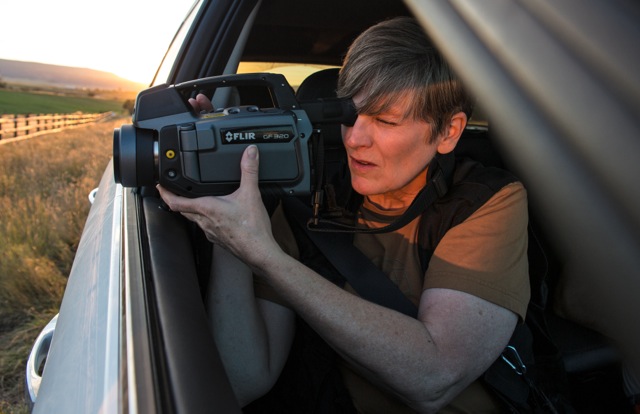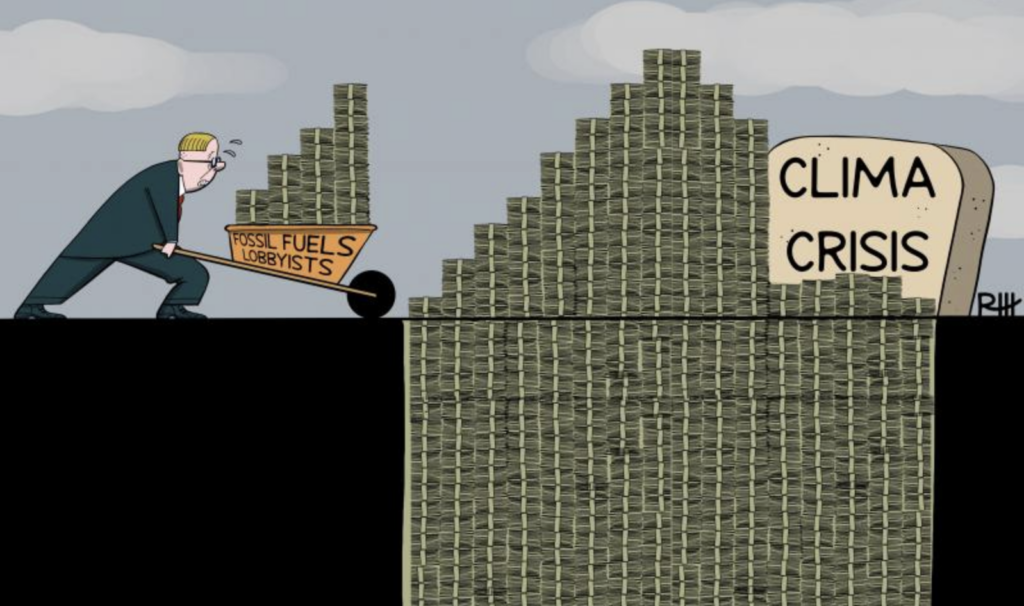A new report from Earthworks shines a light on air pollution, including methane leaks, from oil and gas wells in California, the nation’s third largest oil producing state in 2013 – highlighting the ways that potentially toxic gases from the sites raise red flags for the health of those living nearby.
Published Thursday, the report is the first analysis of California’s oil and gas air pollution based on infrared video footage combined with air sample testing and revealed toxic gases in the air surrounding oil and gas wells in Kern County and Ventura County. Many of the sites tested were at existing oil and gas wells, including one sample drawn while a well was abandoned. People living near the sites were also surveyed.
“Air sampling revealed the presence of 15 compounds known to have negative effects on human health, as well as 11 compounds for which no health data is available,” the researchers reported.
A growing number of Americans live near oil and gas wells. “A recent analysis shows that approximately 5.4 million people, or 14% of the state’s population, live within 1 mile of a well,” the Earthworks report pointed out. In 2013, the Wall Street Journal reported that 15 million people nationwide live within a mile of a well drilled since 2000.
The 56-page report, “Californians At Risk: An Analysis of Health Threats from Oil and Gas Pollution in Two Communities,” was designed to provide preliminary data about what is in the air surrounding those sites and the impacts on surrounding communities.
Using infrared cameras to identify potential leaks, the researchers placed air canisters in the area and then shipped the containers off to a lab for analysis. They collected samples near pump jacks, wastewater pits, downwind from trucks loading fracking supplies, flares, and in other places where residents reported odors and cameras showed signs of leaks.
All of the samples revealed the presence of methane, didichlorodifluoromethane (also known as a form of the potent CFC Freon, banned by the Montreal Protocol) and trichlorofluoromethane (another form of Freon). At times, the air also carried n-hexane, toluene, propane, n-Butane, and other substances often associated with the oil and gas industry.
“We know that there are a host of pollutants and toxic chemicals in oil and gas extraction processes, and my constituents live and work near these facilities,” said Das Williams, California State Assemblymember for the 37th district. “It should make us angry that there is not enough state regulation to protect our friends and neighbors from the health impacts of oil and gas.”
Representatives from the state’s oil and gas industry said that the report failed to prove that air toxins came from oil and gas operations.
“Kern County is a nonattainment area, not just because of oil and gas but because of automobiles and all kinds of other industries,” California Independent Petroleum Association CEO Rock Zierman told the local press, referring to an area that fails to meet federal standards for air quality. “There’s no way to know whether we are the source of whatever they found, if they found anything.”
However, there is some evidence showing that the oil and gas sites were the source of leaks. The camera that the researchers used is specifically designed to help pinpoint emissions.
“The primary benefit of a FLIR camera is that the user can very quickly identify gases or emissions and the precise source of those emissions. Since most of the gases are not visible, and some also without odor, the FLIR is critical in identifying this. The state regulatory agencies, like the TCEQ, use them when investigating odor complaints,” said Tim Ruggiero, a board member of ShaleTest Environmental Testing. “While emission testing is important, it’s also very costly. So before we use a Summa canister at a site, we need to see those emissions first.”
Although many infrared cameras detect heat signatures, the FLIR GF320 cameras used by Earthworks and other oil and gas watchdogs use a more precise technology. “You can buy a nice FLIR camera for $10,000,” explained Calvin Tillman, also a ShaleTest director. “The gasfinder camera costs $85,000— that gives you a sense of the different technology.”
“The camera we use is specifically designed to pick up emissions,” Mr. Tillman added. “It detects volatile compounds.”
Sharon Wilson, Earthwork’s Gulf Regional Organizer using a FLIR camera at a fracking industry site across the street from Michael Smith’s home in Garfield County, CO. ©2104 Julie Dermansky for Earthworks
The Earthworks report also pointed out that its findings were preliminary.
“The results showed that the communities of Upper Ojai in Ventura County, and Lost Hills in Kern County, are being exposed to air contaminants that are typically associated with air emissions from oil and gas development,” the researchers wrote. “However, the frequency and number of samples was limited; therefore, the results of this investigation must be viewed as a snapshot of air emissions and a clear warning sign of problems, not as generalizable results.”
The researchers also conducted health surveys in areas downwind from the oil and gas sites. “In Lost Hills, 92.3 percent of people who responded to the survey reported experiencing odors in their homes or communities, including ‘petroleum, burning oil, rotten eggs, chemicals, chlorine or bleach, a sweet smell, sewage, and ammonia,’” the report says. “When these odors were present, 63 percent of residents said they got a headache, and 37 percent of them said they experienced nausea and dizziness.”
The report points out other possible sources for health complaints, adding “Because agriculture is a major employer in Lost Hills, however, many residents reported being exposed to other chemicals as well: 59 percent said they were exposed to things like pesticides and other ag-related chemicals.”
“As a Registered Nurse I acknowledge the limitations of the study but this only provides a stronger argument for the state to invest in rigorous, unbiased health impact research,” said Lucinda Wasson, retired Director of Public Health Nursing for Kern County. “The CA Department of Public Health, whose first priority is to protect Californians’ health, should be the state agency examining the health threats posed by oil and gas pollution. That California has instead relied only upon DOGGR, the agency charged with encouraging oil and gas development, speaks volumes about where the state’s priorities are regarding the health impacts of oil and gas recovery.”
The report’s authors also called for further investigation into toxic air pollution from the industry.
“The data provides a basis for these two communities, and others living in close proximity to oil and gas development, to request further investigation into health impacts associated with oil and gas production,” the researchers wrote, “and to push policymakers and regulatory agencies to address their health concerns.”
Photo Credit: Sept 14th, 2014, Sharon Wilson, Earthwork’s Gulf Regional Organizer using a FLIR camera in Greeley, Colorado in Weld County. Wilson filmed a fracking site next to Northridge High School. ©2104 Julie Dermansky for Earthworks
Subscribe to our newsletter
Stay up to date with DeSmog news and alerts








